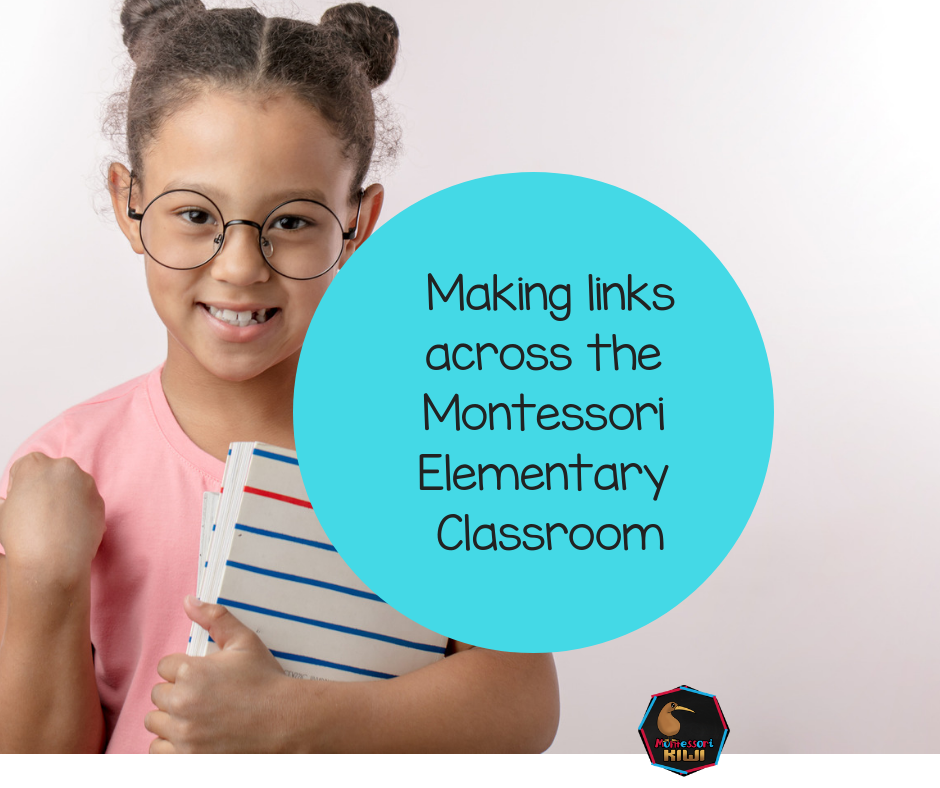
4 ways to make links across the curriculum in the Elementary Classroom
Share

The Montessori curriculum is so vast! What I love about it is how many connections there are in the curriculum. However sometimes in the vastness of the curriculum it can be hard to connect a lesson in say language with a lesson on botany although this is so important!
Helping children make connections ensures students increase their metacognition and also helps children connect curriculum areas rather than thinking 'I just did a language activity, now I am doing a Zoology activity'
1) Ensure children get to hear all of the Great Lessons
Helping children make connections ensures students increase their metacognition and also helps children connect curriculum areas rather than thinking 'I just did a language activity, now I am doing a Zoology activity'
1) Ensure children get to hear all of the Great Lessons
The Great Lessons are at the centre of Cosmic Education, which endevours to help children connect different facets of the cosmos. Broadly the Great Stories each have a different main focus, however when we tell them we can accentuate different areas to draw attention to a particular aspect. For example one time I told the Great Lesson on the coming of Humans I highlighted the part of the story about communication and talking to people to highlight to my class the importance of talking well to each other. This was because communication was a issue of interest in our class at the time!
When we tell the Great Stories we may also start a certain story by saying 'Remember in the story about how the universe was made such and such happened' this draws the child's mind back to the learning that happened in that story and helps make links to what they are learning now. I also find it useful to have students tell me what they remember about the last Great Story.
.
.
In modern teaching vernacular, this is called 'accessing prior knowledge' and is a way of honouring the child's knowledge and of ensuring that new learning connects to prior learning.
..
2) When giving new lessons draw and connect previous learning in other curriculum areas.
As I have alluded to above connecting new learning to prior learning is a great way of connecting learning across the curriculum. Most of us are comfortable linking within a curriculum area. Take Maths for example. A teacher may be giving an introductory lesson to a child on the stamp game and may say something show how the thousand cube is now represented as a tile with 1000 on it. However I have it found it lesson common for teachers to draw knowledge across curriculum areas.
Examples of way to do this:
-Last week we talked about clothes we wear in winter. Can you tell me some of those clothes? Which of those pieces of clothing do you wear more than one of? Hmmm today we are going to talk about the word for 'more than one' That word is plural. The teacher then goes onto to give a lesson on singular and plural bringing in examples the children gave at the beginning of the lesson.
- We have been learning about angles. Do you remember the Clock of Eons/Eras? I wonder what the angles are in that? Can you remember what it looks like? Let's measure them....
3) Encourage 'Going Outs'
I know that in some countries 'Going Out Trips are not easy or are not legal however if you can undertake Going Out trips these are a great way to have students integrate learning! Students undertaking a trip use literacy skills, life skills and most likely another curriculum area e.g. social studies, science.
If these aren't possible a class excursions are essential children can help plan the trip and a range of follow up work can be undertaken.
.
4) Have activities that combine curriculum areas.
Doing Research is a great way to do this. As you will be familiar with, students may choose a topic and then read and write about it.
Doing Research is a great way to do this. As you will be familiar with, students may choose a topic and then read and write about it.


.
Other activities that draw on multiple intelligences are another idea for example:
-Design and Make a model of a house that would be suitable for a very cold part of the world.'
-Design and Make a model of a house that would be suitable for a very cold part of the world.'
In this activity, the child would need to be using the knowledge they had from lessons in Geography, Math, Language and Art.
You may wish to have some of these 'extension' activities laminated on cards and on the shelves for students to choose from. This is a great way of introducing research and independent sustained 'big work' to children who may not be ready for the traditional 'research' proposed in many Montessori Teacher training courses where the child simply picks a topic and goes and reads and then writes about it!
.
5) Most importantly keep the big picture in mind. The day to day activities are not the end goal. I keep this poster in front of my mind to help me see the forest and not the trees!
.
You can also use the arts to help teach language and other curriculum areas.
I've written a blog post on how I have integrated the arts into my curriculum here